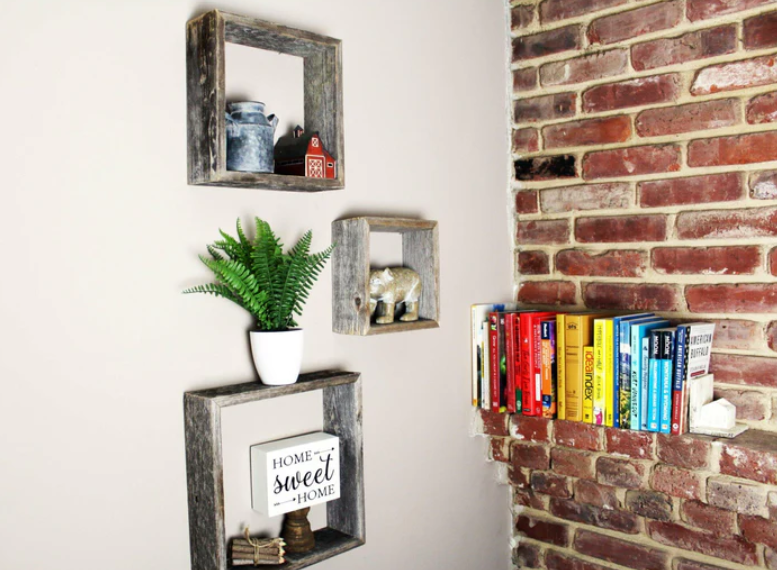In a world that is becoming increasingly dominated by mass production and fast consumption, the attraction to reclaimed wood decor stands out as a true testament to the beauty of craftsmanship, sustainability, and a physical connection to the past. By using reclaimed wood for decor, it allows for you to have that natural wood feel that is flexible in design and style while having a unique piece of history. This blog will explore the origins of reclaimed wood and dig deeper into the captivating world of reclaimed wood decor, where history meets design in each carefully reclaimed piece.
The Roots of Reclaimed Wood
To fully appreciate reclaimed wood, it's essential to understand its historical roots and origin. The use of reclaimed wood dates back centuries, with early civilizations repurposing wood for various purposes. From ancient Egyptian and Roman civilizations to medieval Europe, the practice of reusing timber was driven by both necessity and resourcefulness.
The reclaimed wood you will come across in the present will be anywhere from 100-250 years old (or potentially even older!) This reclaimed wood often comes from structures once erected by American pioneers. Hand hewn beams, some of the oldest we come across, were cut by hand from round logs into square beams for structural support. Within these barns, farmhouses, or warehouses you will find a treasure trove of reclaimed wood varying in thicknesses, patinas, widths, and lengths. You will surely find material that would work for whatever you are working on within these structures.
As the world continues to face heightened environmental challenges, the sustainable nature of reclaimed wood has become increasingly important. Trees have an extremely important impact and roll within our environment. Photosynthesis involves absorbing carbon dioxide from the air and storing it in the wood of trees. Trees and plants store this carbon dioxide throughout their lives, helping to slow the gas buildup in our atmosphere that has been steadily warming our planet and helping to keep it cool. Unlike the depletion caused by logging and deforestation, reclaimed wood involves repurposing existing resources, reducing the demand for fresh timber and contributing to the conservation of forests.

The Journey of Reclaimed Wood: Sourcing and Salvaging
The process of creating reclaimed wood decor begins with the careful sourcing and salvaging of wood from various structures. This can include old barns, farmhouses, factories, warehouses, and even decommissioned army posts. The unique character of reclaimed wood often stems from its previous life, showcasing patinas that come from each specific pieces exposure to elements, knots and grain patterns that show the natural characteristics of the wood species, nailholes and imperfections from its prior use, and wormholes or other characteristics highlighting its past life.
Processing and Milling: Preparing Reclaimed Wood for your Home
Once salvaged, the reclaimed wood goes through a meticulous process of cleaning, de-nailing, and sometimes milling depending on its final use. This process preserves the characteristics of the wood while preparing it for its new life as a piece of decor without altering its authentic appearance. The imperfections that some might consider to be flaws become the very features that make each piece distinct and special. The rich story of the woods' past adds rustic charm to each and every piece.
The Artistry of Reclaimed Wood Decor: Customization and Designs
Reclaimed wood decor is a canvas for your creativity. Craftsmen, artisans, and designers are able to expertly harness the unique qualities of each piece to create custom furniture, accent walls, flooring, and more. The inherent beauty of reclaimed wood allows for a wide range of design possibilities from rustic and farmhouse styles to modern and industrial aesthetics. Use lighter wood tones with character in darker more industrial designs, or within warm interior design styles like coastal or bohemian to provide the perfect, warm compliment to the space. Prefer darker wood? Darker wood adds a pop of contrast to warm and light interiors, or provides a strong accent piece to dark colored fireplaces or on natural brick. No matter what your design style is, reclaimed wood products fit seamlessly into any home or business design.
Furniture and Functional Art
One of the most popular applications of reclaimed wood is in furniture design. From dining tables, bathroom vanities, to chairs, bed frames, and cabinets, reclaimed wood furniture adds a sense of natural warmth and touch of character to any space. The combination of skilled craftsmanship and the distinctiveness of each piece of wood results in functional art that transcends trends and withstands the test of time. Reclaimed wood furniture pieces will have characteristics new lumber will not display, adding further to the appeal of reclaimed wood and the aesthetics that it provides. Even once milled, many of those sought after and unique characteristics still shine through while providing a structurally sound, high quality product.

The Growing Popularity of Reclaimed Wood Decor
As consumers become more environmentally conscious, the demand for sustainable and unique decor has surged. Reclaimed wood decor not only fulfills this criteria but also provides a sense of authenticity and a connection to the past that resonates with individuals seeking a departure from mass-produced, cookie-cutter furnishings and decor items. For our reclaimed items in particular, we provide a custom letter with each order letting you know of its approximate age, the type of structure that it came out of, location of that structure, and the use of the piece when it was within the structure. For the places that we are lucky enough to get a deep history on, we add those to our Wood Origin Stories page along with photos for a more permanent archive and reference.
Interior Design Trends
The versatility of reclaimed wood has allowed for it to seamlessly integrate into various interior design trends. Whether it's the warmth and charm of farmhouse style, the rugged appeal of industrial decor, or the modern elegance of minimalist design, reclaimed wood adapts to diverse aesthetics, making it a timeless choice for designers and homeowners alike. While many love the look of natural wood and its variance in coloration, wood can also be stained to almost any color that you would like. Leave your reclaimed wood decor natural so that you can soak in and enjoy its natural coloration daily, or add a touch of individuality to your pieces by adding a stain, oil, or tint to highlight other decor or colorways in your space. Aside from its color, reclaimed wood can be left and worked with on more of the traditional and rustic side, or can be more refined so that you can still enjoy all of the beautiful characteristics that it carries while having a more cleaned and refined look. If you are drawn to a particular characteristic more than others, you can look for material to use for your project that exudes your favorite traits.
The Importance of a Reputable Reclaimed Wood Business
While the idea of using reclaimed wood is undoubtedly appealing, ensuring the quality and safety of the material can be challenging. Reputable suppliers and manufacturers follow rigorous standards to address concerns related to lead paint, toxins, and structural integrity. Consumers should be informed and vigilant when selecting reclaimed wood products for their homes. It is always important to research the credibility of the company you are considering ordering from. You can also source reclaimed wood and other materials for your project by contacting salvage stores, online marketplaces, local salvage yards, or lumber yards that specialize in reclaimed materials. You can also connect with carpenters and other artisans who specialize in working with reclaimed wood. They can help in guiding you in sourcing the right materials and help bring your design ideas to life.
Pricing and Accessibility: Why is Reclaimed Wood More Expensive than New Lumber?
Due to the labor-intensive process of sourcing and preparing reclaimed wood, the cost of reclaimed wood decor can be higher than that of new, mass-produced alternatives. However, many individuals are willing to invest in these unique pieces for the sake of sustainability, craftsmanship, and the one-of-a-kind stories embedded in each item. In order to obtain reclaimed wood, a structure first has to be sourced. This can be someone who inherited a property and no longer needs, wants, or has a use for the buildings on it, a structure that is for sale, or a case of just ensuring the material is saved from the structures inevitable demise of being turned back into earth or left to rot. Once the structure is sourced, it has to be confirmed that the wood is still in good condition and does not have any rotting or water damage. From there, the structure itself has to be meticulously taken down piece by piece to ensure there is no damage to any of the pieces holding it together. After the building has been dismantled, the material can then be sorted by size and dimension and begin to be de-nailed. If the material was exposed to elements, it will often times be kiln dried prior to working with it. The kiln drying process will remove any additional moisture from the wood that can cause issues down the line, and kills any bugs or bacteria that may be on the pieces in the process. Kiln drying can take 2 week or longer to complete depending on the moisture content of the wood. When the drying is complete, the pieces are ready to be cleaned up and prepared for their new life and use.

Conclusion: Why you should chose Reclaimed Wood Decor
Reclaimed wood decor embodies the perfect blend of history, sustainability, and artistry. As we continue to navigate a world where environmental responsibility and individual expression are more paramount then ever, reclaimed wood stands as a beacon of hope - a reminder that the past can be repurposed to create a more sustainable and visually captivating future. Whether in the form of furniture, accent pieces, or entire architectural elements, reclaimed wood decor invites us to surround ourselves with stories, embrace imperfections, and appreciate the timeless beauty of craftsmanship.


